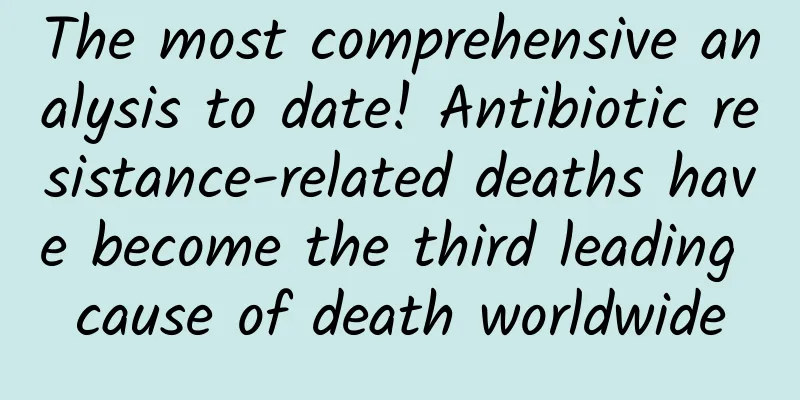The most comprehensive analysis to date! Antibiotic resistance-related deaths have become the third leading cause of death worldwide

|
Written by: Zhu Hengheng Editor: Wang Haha Since the 21st century, due to the progress of the pharmaceutical industry and the abuse of antibiotics, antibiotic resistance has long become a medical problem faced by countries around the world, and has been listed by the World Health Organization as one of the major public health threats facing mankind in the 21st century. In this regard, the World Health Organization and global medical workers all agree that it is necessary to mobilize the resources of countries and governments around the world to solve this problem. However, addressing antibiotic resistance requires understanding the true situation of antibiotic resistance around the world, especially in many places where monitoring data is lacking. However, no study has previously conducted a truly comprehensive analysis of the global situation of antibiotic resistance, which has also led to people not being able to clearly understand the harm of antibiotic resistance. After all, there are still quite a few people who think that antibiotic resistance is alarmist. (Source: Pixabay) Recently, Professor Christopher Murray of the Institute for Health Metrics and Evaluation at the University of Washington collaborated with hundreds of researchers from various research institutions around the world to analyze data related to antibiotic resistance in 2019 in 204 countries and regions around the world. They found that a conservative estimate is that 1.27 million people died directly from antibiotic resistance in 2019, and another 4.95 million deaths were related to antibiotic resistance. This means that in 2019, the number of deaths directly caused by antibiotic resistance was equal to the total number of deaths caused by AIDS and malaria, and antibiotic resistance-related deaths were the third leading cause of death in the world after ischemic heart disease and stroke. It is reported that this is the most comprehensive study on the global burden of antibiotic resistance to date, covering 471 million patient records in 204 countries and regions. Professor Christopher Murray said: "These new data reveal the true scale of global antibiotic resistance. This is a clear signal that we must take immediate action to combat the threat. Previously, the Antibiotic Resistance Review commissioned by the UK government showed that by 2050, antibiotic resistance is expected to cause 10 million deaths. Now we know that reality is already very close to this data. If humans want to maintain their advantage in the future fight against microorganisms, we must make changes now." The study was published in The Lancet under the title "Global burden of bacterial antimicrobial resistance in 2019: a systematic analysis". Antibiotic resistance is an alarmist issue Regarding antibiotic resistance, Dr. Margaret Chan, Director-General of the World Health Organization, once said a very classic statement at the 2016 United Nations General Assembly: "The world is moving towards a post-antibiotic era, where common infections will once again kill people. If current trends continue, complex interventions such as organ transplants, joint replacements, cancer chemotherapy, and premature infant care will become increasingly difficult or even too dangerous. This may even lead to the end of modern medicine as we know it." Many people have not really experienced antibiotic resistance, so they think this statement is a bit alarmist. But in fact, this statement is actually too conservative. To give a very simple example, we all know that before the advent of penicillin, most deaths in wars were caused not by bullets but by wound infections. Infection with super-resistant bacteria means that we have returned to the era before the advent of penicillin, when a small wound or respiratory infection could easily take a life. Of course, some people may say that with the advancement of medical technology, people can develop many new antibiotics to fight super bacteria. But in fact, in recent decades, the most used antibiotics on the market are still products or derivatives developed in the 1980s. (Source: Pixabay) Since 2017, WHO has published an annual report on candidate antibiotics, evaluating antibiotics in clinical testing and early product development. The report examines candidate drugs with the potential to cure the most threatening drug-resistant infections on the WHO Priority Bacterial Pathogens List. The 2020 Antibiotic Candidate Report reveals a near-static state of candidate drug development. Only a handful of antibiotics have been approved by regulatory agencies in recent years. Most of these development-stage drugs have limited clinical efficacy compared to existing therapies, and 82% of recently approved antibiotics are derivatives of existing antibiotic classes where resistance is already common. Therefore, these new drugs are expected to quickly develop resistance. At the same time, since drug development often requires huge costs and there are a series of medical challenges, the success rate of antibiotic product development is not high. In addition, even if antibiotic products can be successfully developed, the return on investment for enterprises is limited. Therefore, few large pharmaceutical companies will actively participate in the development of new antibiotics, further delaying the advent of new antibiotics. Therefore, although antibiotic resistance has been discussed repeatedly, it is definitely not an exaggeration. The real situation of antibiotic resistance Faced with the increasingly serious situation of antibiotic resistance, people are taking effective actions on the existing health system, such as optimizing the use of antibiotics, detecting and controlling infections, and providing more funds to develop new antibiotics and treatments to save more lives. Before taking action, people must comprehensively assess the current status of antibiotic resistance. Previously, although many countries and regions have published reports on the health impact of resistance to a few pathogen-antibiotic combinations, there is a lack of comprehensive assessments of drug combinations for a wide range of pathogens in all regions of the world. To this end, Professor Christopher Murray collaborated with hundreds of researchers from various regions and institutions around the world to obtain 471 million pieces of personal data from systematic literature reviews, hospital electronic systems, and government monitoring systems, and used statistical models to analyze the current status of antibiotic resistance. The analysis of 23 common pathogens and 88 pathogen-drug combinations in 204 regions around the world found that antibiotic resistance directly caused 1.27 million deaths and another 4.95 million deaths were related to it in 2019. In comparison, AIDS and malaria caused 680,000 and 627,000 deaths, respectively, in 2019. Among them, drug resistance caused the most deaths in lower respiratory tract infections such as pneumonia, with more than 400,000 deaths in 2019 and 1.5 million deaths from related diseases. Blood infections such as sepsis directly caused about 370,000 deaths, and 1.5 million deaths were related to this. In addition, drug resistance related to abdominal infections, usually caused by appendicitis, directly caused 210,000 deaths, and 800,000 deaths from related diseases. Among the 23 common drug-resistant pathogens included, drug resistance in only six bacteria, including Escherichia coli, Staphylococcus aureus, Klebsiella pneumoniae, Streptococcus pneumoniae, Acinetobacter baumannii, and Pseudomonas aeruginosa, directly led to 929,000 deaths, and another 3.27 million deaths were related to it. Among them, methicillin-resistant Staphylococcus aureus alone directly led to more than 100,000 deaths. (Source: Pixabay) Of all antibiotics, fluoroquinolones and beta-lactams are the most common causes of resistance. In most pathogens, these two classes of antibiotics are usually the first line of defense against serious infections. Resistance to these two antibiotics directly causes more than 70% of deaths. It is worth noting that the study also found that there are two groups of people who are most vulnerable to antibiotic resistance. The first is people in underdeveloped areas, such as Africa and South Asia, which are the regions with the most serious burden of antibiotic resistance in the world. The mortality rate of antibiotic resistance in these regions is about twice that of developed countries. The second group of people who are most vulnerable to antibiotic resistance are infants and young children. Although people of all ages are threatened by antibiotic resistance, infants and young children are at particularly high risk, with about one-fifth of deaths caused by antibiotic resistance occurring in children under the age of five. Professor Christiane Dolecek, GRAM Scientific Lead, from the Centre for Tropical Medicine Research at the University of Oxford, said: “With resistance levels varying so widely between countries and regions, global data collection is essential so we can better track resistance levels and provide clinicians and policymakers with the tools to respond to the threat of antibiotic resistance.” References: https://www.thelancet.com/journals/lancet/article/PIIS0140-6736(21)02724-0/fulltext#seccestitle70 https://www.thelancet.com/journals/lancet/article/PIIS0140-6736(22)00087-3/fulltext https://www.theguardian.com/society/2022/jan/20/antimicrobial-resistance-antibiotic-resistant-bacterial-infections-deaths-lancet-study Academic headlines |
<<: Where does the oxygen that astronauts breathe in space come from?
>>: Why did ancient civilizations build cities in forests?
Recommend
Android 10 Go version will be launched for phones with less than 1.5GB of memory
According to foreign media reports, last year, An...
Home appliance manufacturers' Internet-oriented transformation helps to consolidate their position as the first screen
As a traditional household appliance, television ...
Java's concise way
[[143085]] Computer scientists place great value ...
The Secret of the Deep Sea Castle: Human, where do you come from?
Some mysteries may never be solved. By Amanda Hei...
Don't eat it! It has 3,000 to 6,000 parasites in its body.
As the temperature rises In parks, wetlands, pond...
How did Facebook achieve 800,000 people watching live broadcasts at the same time?
There are only a handful of companies that know h...
Useful information | Top 10 content marketing methodologies!
I once saw an interesting saying: All the ways to...
Review of the TV version of the beautiful big-screen adventure "Dodo Escape"
Screen: Sound Effects: operate: Plot: Experience:...
Rabbits have actually caused such a disaster to the ecosystem!
Produced by: Science Popularization China Author:...
4 ways to design the background image of the new media Douyin homepage
After completing the account positioning planning...
How do those articles with over 100,000 views come about? Hot articles all follow these 6 principles
How to understand super hit products? For example...
Constipation at a young age? A reliable doctor will teach you some effective methods
Have you tried your best but still can't hear...
Who was the first person to discover global warming? The answer is…丨Hand-drawn weather
March 23rd of each year is World Meteorological D...
Commercialization and monetization guide: How to improve the eCPM of information flow advertising?
Information flow advertising is almost a must for...
2020 Zhihu promotion and traffic generation skills!
Choice is greater than effort? No comment. I don’...









